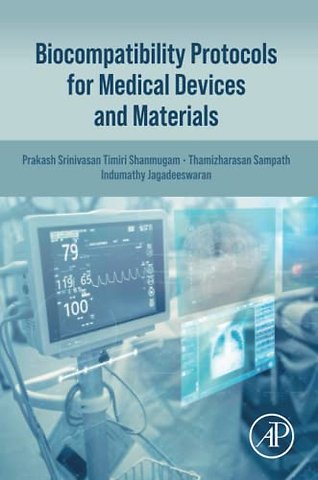<p><br>Contributors<br>Author bios<br>Introduction</p> <p>1.Cytotoxicity<br>Prakash Srinivasan Timiri Shanmugam, Thamizharasan Sampath, Indumathy Jagadeeswaran, Sandhiya Thamizharasan, Safura Fathima and Krithaksha V.</p> <p>Introduction<br>ISO 10993-5<br>Cytotoxicity<br>Detection methods<br>Test by indirect contact<br>Quantitative method<br>Abbreviations<br>References</p> <p>2. Sensitization<br>Prakash Srinivasan Timiri Shanmugam, Thamizharasan Sampath, Indumathy Jagadeeswaran, Sandhiya Thamizharasan and Safura Fathima</p> <p>Introduction <br>ISO 10993-10 <br>Test methods <br>Guinea pig tests <br>Guinea pig tests and sensitization potency assessment <br>Guinea pig maximization and Buehler tests <br>Open epicutaneous test <br>Advantages and limitations <br>Local lymph node assay <br>The LLNA and sensitization potency assessment <br>Advantages and limitations <br>Human skin-sensitization testing <br>Advantages and limitations <br>Application of test methods in risk assessment <br>Guinea pig tests <br>Local lymph node assay <br>Human repeat-insult patch test<br>Abbreviation <br>References </p> <p>3. Irritation test<br>Prakash Srinivasan Timiri Shanmugam, Thamizharasan Sampath and Indumathy Jagadeeswaran</p> <p>Introduction <br>Selection of animals <br>Test procedure <br>Alternative methods <br>In vitro tests methods for irritation <br>References </p> <p>4. Material-mediated pyrogenicity<br>Prakash Srinivasan Timiri Shanmugam, Thamizharasan Sampath, Indumathy Jagadeeswaran, Sandhiya Thamizharasan and Safura Fathima</p> <p>Introduction <br>Broad range of pyrogens <br>Tests using fluid extracts <br>Selection of animal species <br>Animal status <br>Animal care and husbandry <br>Size of groups <br>Number of groups <br>Treatment controls <br>Route of exposure <br>Test sample administration <br>Pyrogen tests <br>LAL test <br>Rabbit test: sham test (in vivo) <br>Interpretation of results <br>Monocyte activation test (in vitro test) <br>Procedure of MAT <br>Advantages <br>Abbreviations <br>References </p> <p>5. Acute systemic toxicity<br>Prakash Srinivasan Timiri Shanmugam, Thamizharasan Sampath and Indumathy Jagadeeswaran</p> <p>Introduction <br>Considerations <br>Acute systemic toxicity <br>Selection of animals <br>Animal status <br>Animal care and husbandry <br>Size and number of groups <br>Routes of exposure <br>Dosing <br>Body weight and food/water consumption <br>Clinical observations <br>Clinical pathology <br>Anatomic pathology <br>Evaluation criteria <br>Final report <br>References </p> <p>6. Repeated-exposure systemic toxicity (subacute, subchronic, and chronic systemic toxicity)<br>Prakash Srinivasan Timiri Shanmugam, Thamizharasan Sampath, Indumathy Jagadeeswaran and Harini Sriram</p> <p>Introduction <br>Animal care and husbandry <br>Size and number of groups <br>Routes of exposure <br>Dosing <br>Clinical observations <br>Clinical pathology <br>Anatomic pathology <br>Evaluation criteria <br>Final report <br>References </p> <p>7. Implantation<br>Prakash Srinivasan Timiri Shanmugam, Thamizharasan Sampath and Indumathy Jagadeeswaran</p> <p>Introduction <br>Selection of animals <br>Test procedure <br>References </p> <p>8. Hemocompatibility<br>Prakash Srinivasan Timiri Shanmugam, Thamizharasan Sampath, Indumathy Jagadeeswaran, Krithaksha V., Vinod P. Bhalerao and Sandhiya Thamizharasan</p> <p>Highlights <br>Introduction <br>Types of devices in contact with blood <br>Characterization of blood interactions <br>Categories of tests and blood interactions <br>Preclinical evaluation of cardiovascular devices and prostheses <br>Advantages and limitations of animal and in vitro testing <br>Laboratory testsdprinciples, scientific basis, and interpretation <br>Evaluation of hemolytic properties of medical devices and their components <br>Hemolysis testingdgeneral considerations <br>Abbreviations <br>References </p> <p>9. Tests for genotoxicity<br>Prakash Srinivasan Timiri Shanmugam, Thamizharasan Sampath, Indumathy Jagadeeswaran and Harini Sriram</p> <p>Introduction <br>Requirements <br>Genotoxicity <br>Example test method: mouse lymphoma mutagenesis assay <br>Evaluation criteria <br>Results <br>Conclusion <br>References </p> <p>10. Carcinogenicity<br>Prakash Srinivasan Timiri Shanmugam, Thamizharasan Sampath, Indumathy Jagadeeswaran, Safura Fathima and Sandhiya Thamizharasan</p> <p>Introduction <br>Carcinogenicity test-specific considerations <br>Abbreviations <br>References </p> <p>11. Reproduction toxicity<br>Prakash Srinivasan Timiri Shanmugam, Thamizharasan Sampath, Indumathy Jagadeeswaran, Sandhiya Thamizharasan and Safura Fathima</p> <p>Introduction <br>Principle of the test <br>Description of the method <br>Procedure <br>Data and reporting <br>Abbreviations <br>References </p> <p>12. Toxicokinetics<br>Prakash Srinivasan Timiri Shanmugam, Thamizharasan Sampath, Indumathy Jagadeeswaran, Vinod P. Bhalerao, Sandhiya Thamizharasan, Krithaksha V. and Jayanta Saha</p> <p>Introduction <br>Principles for design of toxicokinetic studies <br>Guidance on test methods <br>Toxicokinetic study sampling <br>Toxicokinetic study report <br>Guidance on specific types of test <br>Absorption <br>Distribution <br>Metabolism and excretion <br>Abbreviations <br>References </p> <p>13. Data leverage<br>Prakash Srinivasan Timiri Shanmugam, Thamizharasan Sampath and Indumathy Jagadeeswaran</p> <p>Introduction <br>Leverage from literature <br>Leverage from Threshold of Toxicological Concern (TTC) <br>Leverage from reviewed devices <br>Leverage from vendors testing <br>References </p> <p>14. Chemical characterization<br>Prakash Srinivasan Timiri Shanmugam, Thamizharasan Sampath, Indumathy Jagadeeswaran, Sandhiya Thamizharasan and Krithaksha V.</p> <p>Introduction <br>Why characterize materials? <br>Chemical characterization <br>Material characterization <br>Plasticizers <br>Sterilization techniques used for medical devices <br>Corrosion <br>Extractables and leachables <br>Set up a chemical characterization study <br>Conclusion <br>References </p> <p>15. Biological evaluation report<br>Prakash Srinivasan Timiri Shanmugam, Thamizharasan Sampath and Indumathy Jagadeeswaran</p> <p>Contents <br>Index <br></p>
